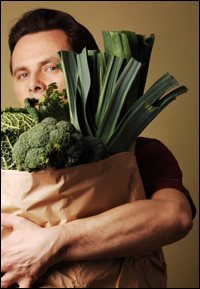Hi Umbra,
Quick question: What is the best way to store vegetables in the refrigerator? I have a small crisper drawer and lots of vegetables from the CSA box. I don’t want to use plastic bags but unfortunately they work well. Any suggestions? Thanks!
Kati N.
Washington, D.C.
Dearest Kati,
Did you say CSA box? You mean, you subscribed to a Community Supported Agriculture farm and are receiving weekly boxes of delicious, fresh, local vegetables? And you need to store them properly so as to have tasty, vegetable-centered meals for every day of the week until you get your box again? Is that what you mean? Me, too! Go CSA go!

Lettuce eat veggies!
By the way, Mark Bittman wrote an excellent article recently in The New York Times about how to eat less meat — not why, just how. Highly recommended, fellow environmentalists.
As we discuss the urgent issue of keeping yummy produce fresh, please keep in mind that there is little environmental distinction between the overall footprints of plastic bags and paper bags. I recommend using both bags, in various situations, meaning: recycled-content, PVC-free, phthalate-free, reused (if possible) bags of either type. As found in your local hippie food store, your mainstream-but-paying-attention-to-trends grocery, or online.
Now, some general tips on storing produce:
1) Most fruit should be kept out of the fridge unless it is on the verge of spoilage. Everything traditionally known as fruit is included in this rule, plus tomatoes, but not zucchini. The fridge is a dry environment, and it dries out the fruit, fills it with strange fridge-odor-derived flavors, and kills the taste.
2) There is no need to refrigerate potatoes, onions, or garlic as long as you have a cool, dry cupboard in your home.
3) Much produce suffers from being washed and then stored. Especially do not store washed basil or mushrooms in a plastic bag; you will end up sad. I like to wash all my lettuce-y items at once and quickly pull them out for salads later, which presents the wetness problem. If I do have wet lettuce or salad mix or basil, I put it in a paper bag and then into a plastic bag; others add a paper towel inside the plastic. Somehow the paper absorbs the moisture out of the leaves, yet keeps them moist enough that they don’t wilt. I think turnip greens, beet greens, and other tough greens might benefit from light washing before storage — I’ve read conflicting things and have never tried washing them. We’ll have to experiment.
4) As you know from experience, almost all other veggies will wilt, shrivel, pucker, and rot at a more rapid pace if not encased in some type of vapor barrier. I’ve never found a crisper drawer that works, so I use and reuse plastic bags, which trap some of the moisture and delay spoilage. (There seems to be a fine line between enclosing natural moisture in a plastic bag and adding moisture in the form of washing.) Any closed container should also work, including Tupperware-type containers made of plastic or glass — Pyrex makes a few.
Think how much moister your own skin would be if you wore plastic bags close to the skin on a daily basis. Since applying lotion to a vegetable will never make it appear younger and fresher, we must resort to using bags or resealable containers. And we must consume our vegetables on a first-to-rot, first-to-eat schedule.
Have a great time with your summer produce, and don’t worry too much about which type of bag you use. Fresh, healthy, local food is a higher priority.
Cukely,
Umbra

